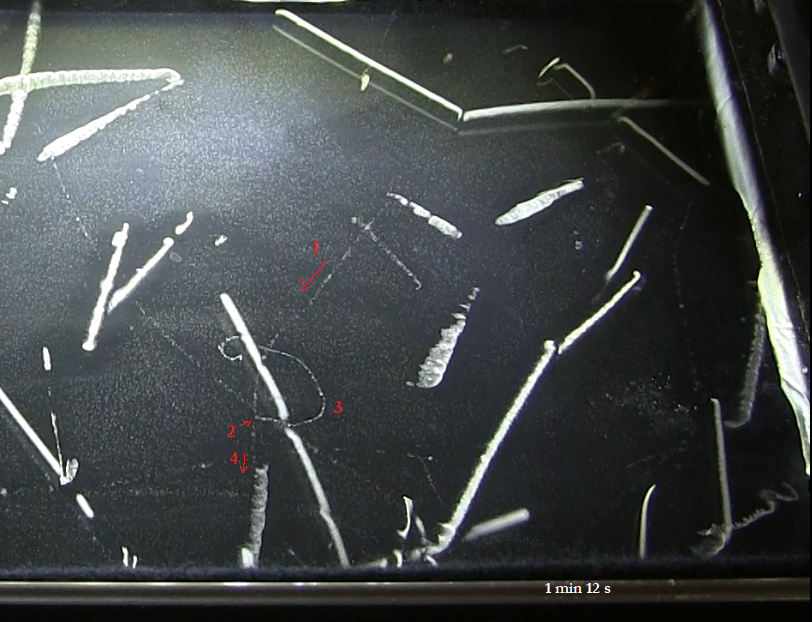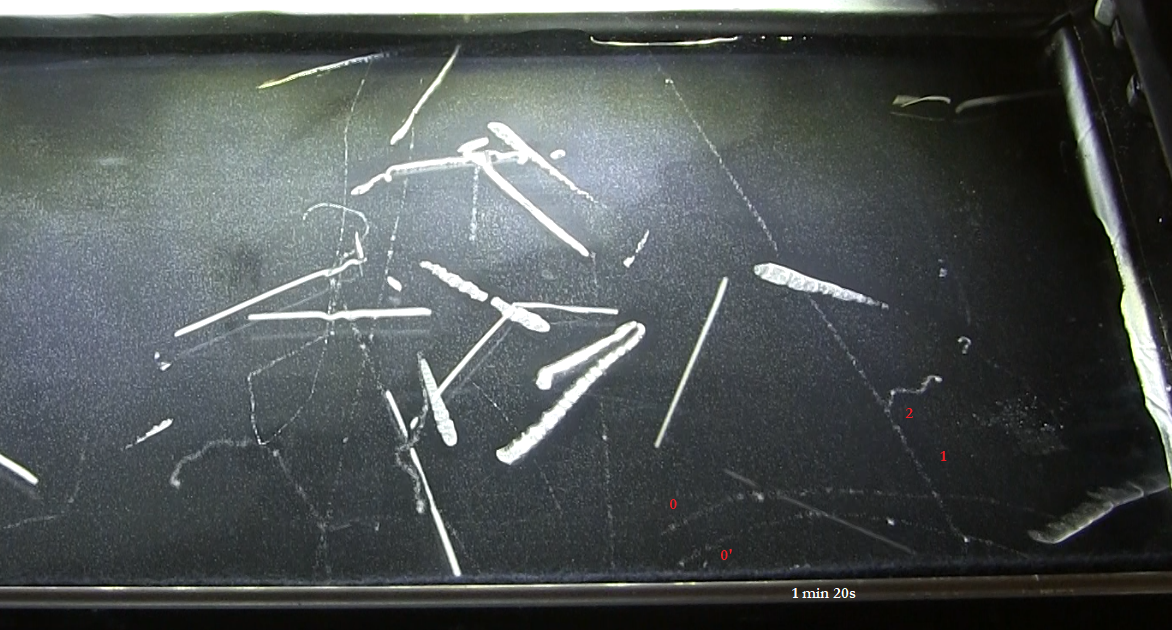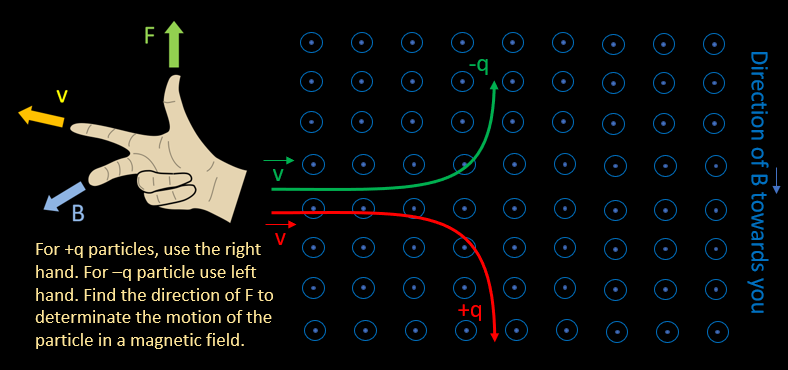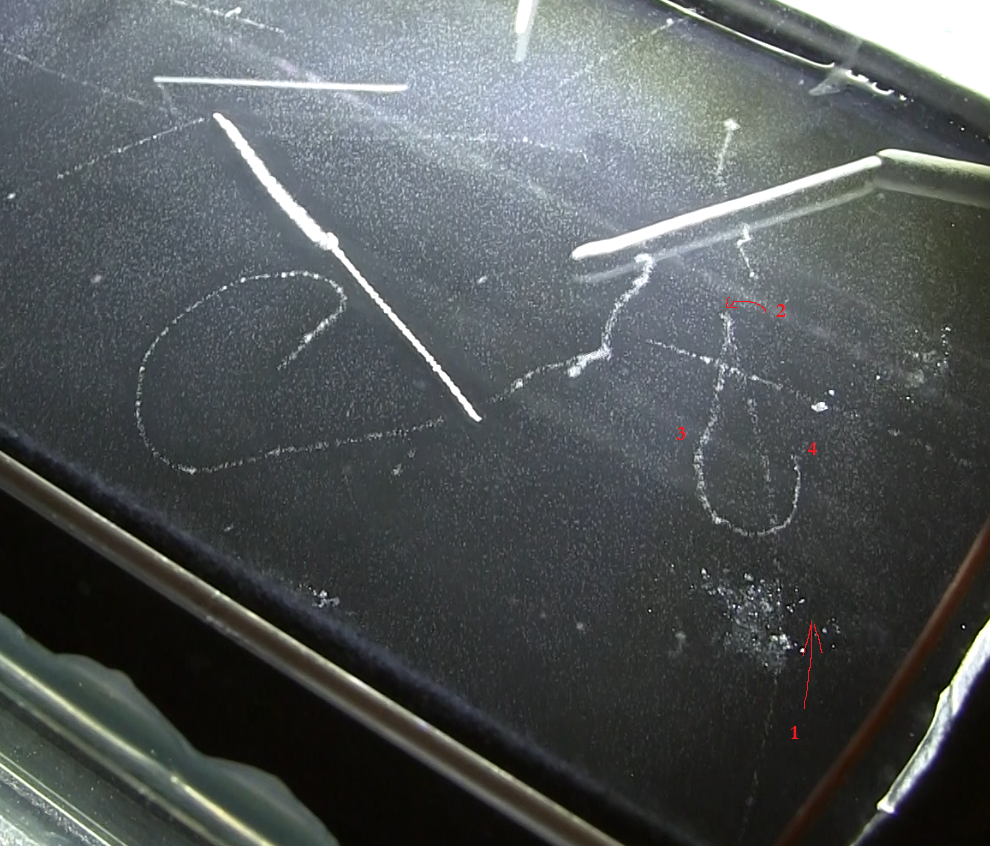2) A scientific experiment
The machine should allow the use of magnetic fields to observe the deflection of light particles (electrons, positons, slow muons). A magnetic field allows to discriminate between positive and negative particles just by looking at their direction of deviation. The magnetic field B is created by a NdFeB magnet put 30 mm under the active surface. The intensity of magnetic field in the chamber is about 50 mT.
The North face of the magnet (direction of B) is located under the active surface and pointing ‘to us’. According to the right hand rule , a charged particle will curve perpendicularly to both the velocity vector v and the B field. So a positon (+q) will curve to the right and an electron (-q), to the left.
Examples with some pictures taken from the videos in this page. Without a magnetic field it’s impossible to say if we are observing an electron or a positon, unless we are looking at a delta ray, which is an electron ejected from an atom by an incoming particle. So we must find a delta ray to check the directions of motion of negative particles in the chamber :

We have to find a recognizable negative particle to determinate the direction of curvature. Only delta ray (electron coming from the ionization of an atom) can give this information.
The above picture is taken at 1 min 12 from the video, after 2 hours of run. At the position 1 above we have a particle travelling downward and at 2, it produces a delta ray (ionization of an atom). The ejected electron is going towards left making a curve at position 3. So, as we said, electron indeed moves « to the left » in the chamber, according to the direction of B field.
Let’s now study another picture :
Above : An electron of high energy at point 1 is moving upward and undergo a hard electrostatic collision with a nucleus at point 2 (we described this event there). The nucleus can be from an atom of O,C,N,H… In the collision, the electron loses a great amount of energy by Bremsstrahlung as the angle of diffusion is about 140°, so it almost bounced back ! In 3 as the Lorentz force is bigger with particles of few kinetic energy (low velocity), the electron is strongly deflected towards the left and end in point 4, when all it’s kinetic energy is depleted. As we previously observed in the last picture that an electron is deflected towards the left, we are now certain that the whole track was an electron and not a positon. Can you see something new in the same picture? Just look the beautiful curve at the middle-left. The particle is deflected to the…right, it’s a positon ! (produced from a gamma annihilation).

Proton moving upward with a delta ray. Find this event at 1 min 20 seconds in the video « after 2 hours of run ».
Above : here we have something new. We know that there is a magnetic field in the left bottom corner of the chamber. But at 1 we have a track which undergo no deflection. Lorentz force says that it’s proportional to the velocity and the mass of the particle (remember that the radius of curvature = mv/Bq). So a fast or a massive particle will have R→∞ and so no curvature can be seen : the trajectory will be linear. That’s what we observe in the picture. Looking at the angle of emission of the delta ray produced in point 2, we can affirm that the particle is moving upward. The little delta ray tries to move to the left (it feels the Lorentz force because of it’s low kinetic energy) but it fails making a nice curve, because at mid range it expect a nuclear collision that bounces it upward.
Back to the primary particle 1. The absence of deflection means that the particle is massive or have a great velocity, or both. The density of ionization (number of droplets in the track) is important. We know that heavy particles are much more excitating/ionising than electrons, thus produce denser tracks. You can compare the density of the track 1 to the one of electrons present in the far left of the picture : electron’s tracks are thinier, about to 3 to 4 times less than the track 1. So it’s not an electron (or positon). Could it be a muon? Very unlikely, because we know that the horizontal flux of muons is about 300 times less than the vertical flux. The video was taken in a room above 2,5 m of the ground surrounded by buildings. The direction of motion of the particle imply that if it was a muon, it would have traversed about 500 concrete walls before coming to the cloud chamber, so it would have an enormous initial energy, which looks quite impossible from the intensity curve of muon flux at sea level. A muon has a mass of 207 me so we should have observed a very slight deflection, but there is nothing like that here. Could it be a proton? Very likely, because protons are created locally anywhere by natural neutrons. It may have been produced in the glass wall of the chamber at an energy of a few dozen MeV, and its great mass (937 me) makes it insensitive to the magnetic field.

